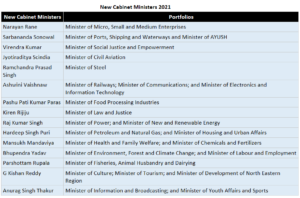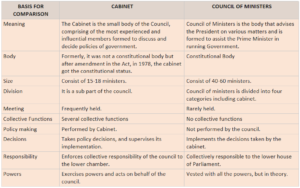In a major shake up of his Council of Ministers almost midway through his second term, Prime Minister Narendra Modi oversaw the swearing-in of 43 Ministers (new and seven promotions to Cabinet rank) and dropped 12 Ministers (seven Cabinet and five Ministers of State)
Dimensions
- What is Cabinet Reshuffle and How is it done?
- Minister : Appointment, Functions and Powers
- What is a Cabinet?
- Types of Ministers
- Difference between Cabinet and Council of Ministers
- Constitutional Position of both
Content:
What is Cabinet Reshuffle and How is it done?
- In a cabinet reshuffle or shuffle a head of government rotates or changes the composition of ministers in their cabinet, or when the Head of State changes the head of government and a number of ministers.
- Cabinet reshuffles happen in parliamentary systems for a variety of reasons.
- Periodically, smaller reshuffles are needed to replace ministers who have resigned, retired or died.
- Reshuffles are also a way for a premier to “refresh” the government, often in the face of poor polling numbers; remove poor performers; and reward supporters and punish others.

Minister : Appointment, Functions and Powers
- The Government of India exercises its executive authority through a number of government ministries or departments of state.
- A ministry is composed of employed officials, known as civil servants, and is politically accountable through a minister.
- Two articles – Article 74 and Article 75 of the Indian Constitution deal with the Council of Ministers.
Appointment:
Article 75 mentions the following things:
- They are appointed by the President on the advice of Prime Minister
- They along with the Prime Minister of India form 15% of the total strength of the lower house i.e. Lok Sabha. (The number cannot exceed 15%)
- The ministers hold office during the pleasure of the president, which means that the President can remove a minister even at a time when the council of ministers enjoys the confidence of the Lok Sabha.
- the President removes a minister only on the advice of the Prime Minister.
- 91st Amendment Act provided for the disqualification of the minister when he stands disqualified as a member of Parliament.
- A Minister ceases to exist as one if he is not a member of either house of Parliament for six consecutive months.
- Parliament decides the salary and allowances of the council of ministers.
A person who is currently not a member of either Lok Sabha or the Rajya Sabha can also be appointed as a minister.
But, he must become a member of either House within 6 months (either by election or by nomination). Otherwise, he ceases to be a minister.
Powers and Functions:
- Every minister has the right to speak and take part in the proceedings of either House, any joint sitting of the Houses and any parliamentary committee he is appointed as the member. But the minister shall not be entitled to vote.
- In Indian politico-administrative system, real executive authority is vested with the council of ministers headed by the prime minister.
Article 74 mentions that:
- The council will be headed by the Prime Minister of India and will aid and advise the President.
- The 42nd and 44th Constitutional Amendment Acts have made the advice of COuncil of Ministers binding on the President.
- The nature of advice tendered by ministers to the President cannot be enquired by any court.
- This emphasises the close and the confidential relationship between the President and the ministers.
Types of Ministers:
The Indian Constitution does not categorize ministers into ranks, however, in practice seen in India, ministers are of four types. The difference between them lies in their respective ranks, emoluments, and political importance.
- Cabinet Ministers—He is present and he participates in every meeting of the Cabinet.
- Minister of State with independent charge—He is a Minister of State who does not work under a Cabinet Minister. When any matter concerning his Department is on the agenda of the Cabinet, he is invited to attend the meeting.
- Minister of State—He is a Minister who does not have independent charge of any Department and works under a Cabinet Minister. The work to such a Minister is allotted by his Cabinet Minister.
- Deputy Minister—He is a Minister who works under a Cabinet Minister or a Minister of State with independent charge. His work is allotted by the Minister under whom he is working.
Difference between Cabinet and Council of Ministers
Cabinet:
- The Cabinet is the core of the Council of Ministers.
- It consists of 15-18 members, who are the senior most and in fact the most effective ministers of the council.
- Prime Minister along with the cabinet ministers deliberate and decide various policies of national governance.
- The cabinet ministers hold important portfolios such as Home, Defence, External Affairs, Atomic Energy, Petroleum and so on.
- As the cabinet ministers jointly form the central decision-making authority of the nation, the Prime Minister selects them with much care.
The following points are substantial differences between cabinet and council of ministers:
- The Cabinet is the small body of the Council of Ministers, composed of the most experienced and influential members formed to discuss and decide policies of the government. Council of Ministers is the body that advises the President on various matters and is formed to assist the Prime Minister in running the Government.
- The cabinet consists of 15-18 members, which comprise senior-most ministers. Conversely, the council of ministers is a bigger body, consisting of 40-60 members.
- The cabinet itself is the sub-part of the council of ministers whereas the Prime Ministers distributes ranks and portfolios to the ministers and in this way, the Council is divided into various classes of ministers.
- The cabinet meetings are frequently held, i.e. once in a week, to discuss and take decisions on various matters. As against this, the meetings of the council of ministers are rarely held.
- The cabinet has several collective functions, while the council of ministers does not have collective functions.
- Policies are made by the Cabinet and not by the council of ministers.
- The cabinet takes decisions relating to policies and monitors its implementation by the council of ministers. On the contrary, the council of ministers implements the decisions of the cabinet.
- The cabinet enforces collective responsibility of the council of ministers to the House of People. Unlike, the council of ministers who are responsible to the House of People, i.e. Lok Sabha.
- As per the constitutions, all the powers are vested in the Council of Ministers, but the Cabinet actually exercises these powers.

Constitutional Position of both:
Council of Ministers is a constitutional body, dealt in detail by the Articles 74 and 75 of the
Constitution.
However, The constitution is silent on its size and classification. Usually, its size is
determined by the prime minister according to requirements of the time. But size should not be more than 15% of the total strength of the lower house of the Parliament.
Originally, the Cabinet was not a constitutional body. It was conferred the status of a constitutional body after the passing of the 44th Constitutional Amendment Act 1978. The term cabinet is mentioned only once in the article 352.
Mould your thought: Differentiate between the Cabinet and Council of Ministers in reference to Indian Politico-administrative setup.
Approach to the answer:
- Introduction
- Define Cabinet and Council of Ministers
- Identify the constitutional status and provisions related to each of them
- Discuss the major differences between them
- Conclusion
















